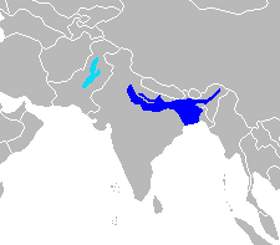Habitat
The Ganges River Dolphin is located in the Ganges,
Brahmaputra, Karnaphuli-Sangu, and Meghna rivers. The region
stretched from the Himalayas to India, Bangladesh, Nepal, and
Bhutan. The
Ganges River is one of the most polluted rivers in
the world. Eight
percent of the world depends on the river, but contact with
humans and
 pollution
is putting the dolphin in danger of becoming extinct. Their
environment is shrinking due to barrages, heavy siltation,
chemical fertilizers, gill-nets, and poaching for oil and meat.
This is also causing their population as a whole to shrink. It
is estimated that there is only about 1200 to 1800 Ganges River
dolphins left. The biggest reason for their population decline
is lack of food, especially fish (Bashir et al., 2011).
pollution
is putting the dolphin in danger of becoming extinct. Their
environment is shrinking due to barrages, heavy siltation,
chemical fertilizers, gill-nets, and poaching for oil and meat.
This is also causing their population as a whole to shrink. It
is estimated that there is only about 1200 to 1800 Ganges River
dolphins left. The biggest reason for their population decline
is lack of food, especially fish (Bashir et al., 2011).
Because of their location, the environment experiences dry seasons and wet seasons. During the dry season, water levels are low and resources are limited for the dolphin. In contrast, the wet season has much higher water levels and provides more abundant resources. Fisheries have also become a concern for the dolphin. In places like the upstream of the river stretch, there is high fishing intensity, along with little depth during both seasons. This makes is harder for the dolphin to survive in this area. During the dry season, dolphins tend to find locations that have a deeper water level to ensure their survival and as the wet season comes along, there is more space to swim about, so food becomes more of a priority (Swinton & Gomez, 2009).
Other animals, such as crododiles, fish, and sharks, also live in these rivers.
To learn more about this endangered animal, and what WWF is doing, click here.
.jpg)